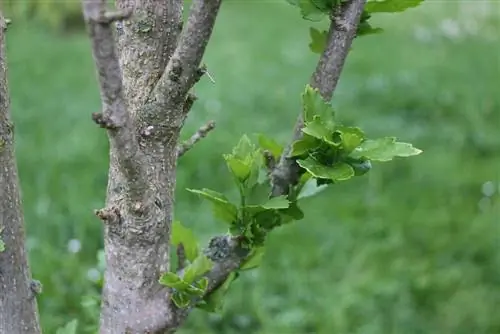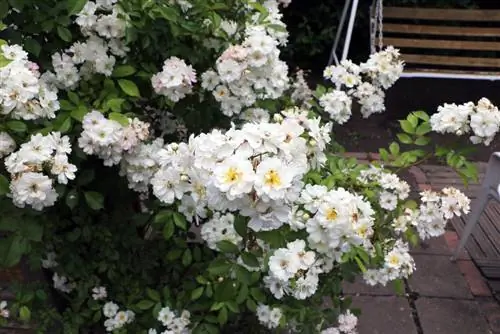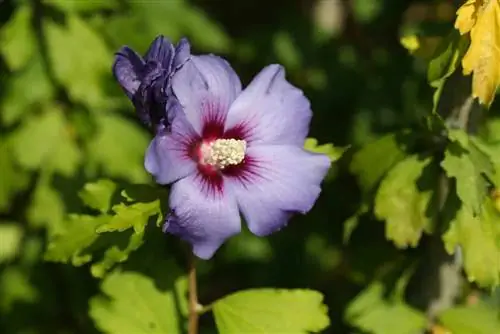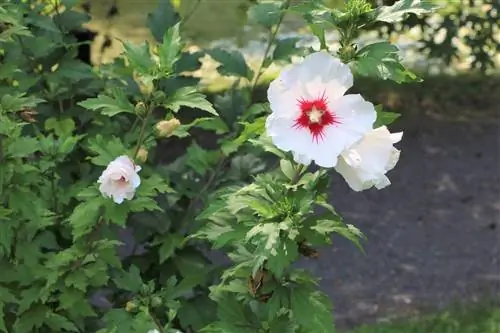- Author admin [email protected].
- Public 2023-12-17 03:39.
- Last modified 2025-01-24 12:45.
The Hibiscus rosa-sinensis is also called rose marshmallow, belongs to the mallow family and is a popular ornamental plant in the local latitudes. The marshmallow comes from tropical regions and is not hardy, which is why year-round gardening is only possible in frost-free regions. The rose marshmallow blooms periodically almost all year round and enchants with lush and colorful flowers. If there is enough space, the Hibiscus rosa-sinensis grows like a bush in height and width and can take on large dimensions.
Location & plant substrate
The rose marshmallow prefers warm locations with intense sunlight. In winter, the flowering plant needs a place in a consistently temperature-controlled room; in summer, it can be moved outside. The planting substrate should not be too compacted, otherwise shoot growth may be restricted. The following aspects must be taken into account when considering the location and the planting substrate:
- Warm and sunny to full sun locations are ideal
- Year-round cultivation possible at constant room temperature
- When kept indoors, however, sensitive to the blazing midday sun and excessive heat
- Put outside during the summer months
- In summer, sheltered garden courtyards, balconies and terraces are ideal
- Nutritious and permeable plant substrate
- Prefers soil rich in humus and enriched with compost
Tip:
When adapting to an outdoor location, ideally first place it in cloudy weather or in the shade for a few days to harden the rose marshmallow. This way the flowers and leaves won't burn.
Watering & Fertilizing
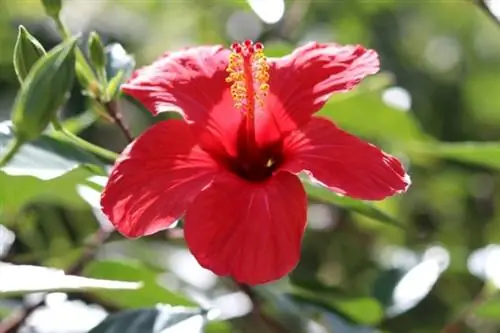
The Hibiscus rosa-sinensis has a relatively high water requirement, but no excess water should remain in the planter in the long term. In this case, the roots gradually die off, with the plant first dropping the undeveloped flower buds and then the leaves turning yellow and then drying up. This phenomenon is similar to drying out, as the rose marshmallow can no longer absorb irrigation water due to the dead root system. The following advice will help with watering and fertilizing:
- Water regularly, but don't overdo it
- Avoid waterlogging at all costs
- Do not leave excess water in the saucer
- Only water again when the top layer of soil has dried slightly
- Appreciates high humidity, spray periodically with water vapor
- Never let the root ball dry out completely
- Administer liquid fertilizer for flowering plants from specialist retailers every 2 weeks
- Fertilize only during the growing season from spring to autumn
Tip:
For an optimal supply of nutrients, it is advisable to incorporate horn shavings into the planting substrate, in this way the rose marshmallow receives an additional and potent long-term fertilizer.
Leaves, flowers & growth
The rose marshmallow can grow several meters high if the site conditions are favorable and well cared for, a circumstance that must be taken into account when selecting the location and the planter. The plant constantly produces new flowers, but these usually wither after just one day:
- Perennial and evergreen plant
- Round, shrub-like and spreading growth form
- Can grow up to 3 m high in a pot, even up to 5 m when planted out in southern countries
- Dark green and shiny foliage, with an oval shape that ends in a point
- Serrated leaf edge
- Magnificent funnel-shaped flowers
- Flowers in yellow, crimson, pink, orange and white colors
- Flowering period from August to October
Repotting
Due to the good growth, it can quickly happen that the planter for the rose marshmallow becomes too small and the roots grow out of it. In this case you need to repot:
- Only repot when the blooms fade in spring
- Choose a sufficiently large planter
- Carefully remove the root ball from the old bucket and move it
- Enrich the plant substrate in the new planter with additional nutrients
Cutting
If the Hibiscus rosa-sinensis is supplied with sufficient nutrients, it will grow strongly in height and width. Growth occurs in spurts throughout the year, with the exception of the winter months. As a late bloomer, the rose marshmallow blooms on its new shoots, i.e. on the annual wood. That's why the plant blooms particularly beautifully after a strong pruning, which produces strong new growth. The following procedure has proven successful when pruning:
- Annual pruning maintains a bushy and multi-shooting growth habit
- Needs strong pruning if you don't want the plant to grow too big
- Can be radically cut down to approx. 15 cm
- Apply more extreme pruning every 2-3 years
- Additional thinning if necessary
- Prune after flowering in autumn
- Alternatively, prune when budding begins in early spring
- Make the cut into the old wood
- Without pruning, the flowering diminishes and the shrub ages
Tip:
If the Hibiscus rosa-sinensis is grown as a standard tree, the shoots on the trunk must be removed all year round and the crown trimmed to the desired shape.
Wintering
Due to its origins in tropical climes, the rose marshmallow is very sensitive to frost and needs a frost-free winter quarters during the cold season. When kept indoors, the Hibiscus rosa-sinensis can remain in its place if it is not in the immediate vicinity of a heater that is constantly in operation. If the plant was placed in the garden, on the terrace or on the balcony over the summer months, it should be brought into the house by October at the latest, before the first night frosts:
- Place in a protected place in winter, at a constant temperature of approx. 15° C
- Keep cool, but not too cold
- Tolerates cold only up to approx. 10° C
- Needs a bright location without the risk of frost
- Reduce watering processes, but do not allow them to dry out completely
- Adjust fertilizer doses
- Needs rest period in winter for subsequent flowering
- Blooms worse without a previous rest period
Propagate

The rose marshmallow is usually easy to propagate if the site conditions are right:
- Propagate with cuttings that root well
- Generate cuttings from pruning
- Propagation with seeds also possible
Diseases & Pests
If there are care errors and incorrect location conditions, the rose marshmallow is sensitive to diseases and pests:
- The roots die when waterlogged and dry
- Tends to infestation with aphids, treat these with a solution of soft soap
- Mildew if the immune system is too weak
- Change location and care if infested
Conclusion
With the correct location conditions and good care, the Hibiscus rosa-sinensis thanks you with magnificent growth and sprawling flowers in wonderful colors. Since the shrub is not frost-hardy, it needs appropriate winter quarters to avoid freezing to death. The distinctive flowering plant requires a lot of care, but is an ornament for any location. If mistakes are made when caring for the rose marshmallow, the flowering and growth will decrease significantly and this will tend to develop aphids and mildew. Pruning must be carried out every year in order to keep the flowering phases evenly strong and to curb the sprawling growth.
Care tips
- A rose marshmallow needs a lot of light and a lot of water, but it cannot tolerate waterlogging. If the roots are constantly wet, they will be damaged and will no longer be able to absorb water.
- If a Hibscus rosa-sinensis drops its undeveloped buds and the leaves change color to yellow, this is either due to a lack of irrigation water or due to waterlogging.
- In both cases, the plant suffers from drought because there is no longer any moisture available in the stems and leaves. It is normal for flowers to wilt after just one day.
- The hibiscus constantly produces new flowers. The high humidity desired by a rose marshmallow can be achieved by occasional misting.
- To ensure that a hibiscus is well supplied with nutrients, it should receive a humus-rich substrate enriched with compost.
- Horn shavings can be used as an additional long-term fertilizer. Nevertheless, fertilizer in the form of liquid fertilizer should be applied every two weeks from April to autumn.
- A soft soap solution is recommended for aphid infestations.


